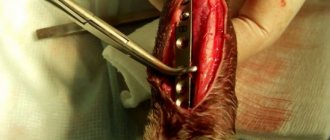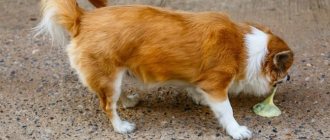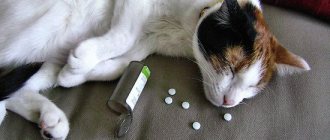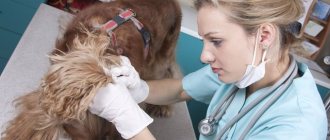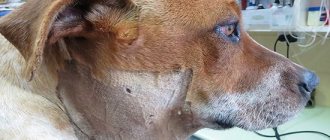Poisoning in dogs has been quite common in recent years. Basically, if a dog is poisoned, the owner of the dog is usually to blame.
Most often a dog can get poisoned when:
- During a walk, he has the opportunity to pick up low-quality food waste.
- Feeding poor quality, spoiled, sour food products.
- Failure to comply with food storage rules and regulations.
- Free access for the dog to household chemicals, fertilizers, and medicines.
- Including a large amount of meat products in your dog's diet.
Types of poisoning in dogs
Depending on the route of penetration of the poison, poisoning in dogs can be food or non-food. Despite popular belief, the first type of pathology is not always associated with food.
Food
Food poisoning in dogs occurs when a dangerous irritant is ingested and enters the gastrointestinal tract. An animal can suffer not only from food, but also from medicines or household chemicals left unattended.
Non-food
The non-edible form occurs when toxins are inhaled, come into contact with the skin and mucous membranes, and also when they enter directly into the blood. The main causes of this type of intoxication include caustic substances, chemical gases, spider and snake bites.
The penetration of poisons through the bloodstream is the most dangerous. It is accompanied by rapid damage to the central nervous system and can lead to death in 30-60 minutes.
Symptoms and their differences depending on the type of poisoning and poison
If a pet is poisoned by spoiled or prohibited foods, then its gastrointestinal tract suffers first of all. The malaise can be easily traced by bloating and tenderness of the abdomen, diarrhea and vomiting. The vomit may contain pieces of food, bile and mucus inclusions. The poisoned person loses his appetite and drinks a lot.
If, instead of an expired bun, the dog managed to swallow floor cleaner, then he will not get away with a simple stomach upset. In addition to the cause of intoxication, the severity of symptoms is affected by:
- the amount of toxins entering the body;
- the strength of the animal's immunity;
- time of exposure to poison.
In addition to vomiting and diarrhea, the main symptoms and signs of poisoning in dogs include behavioral changes (hyperactivity or apathy), excessive salivation, rapid breathing and central nervous system disorders (trembling, convulsions, paralysis). A detailed clinical picture characteristic of a particular type of poison can be found below.
Houseplants
Eating poisonous flowers results in foamy vomiting, increased heart rate and heavy breathing. There is dilation of the pupils, apathy, loss of appetite and trembling of the limbs.
Medicines
If a dog swallows medications left unattended, then first of all they will affect his behavior - it will be unusually lethargic or too active. Possible drowsiness, loss of appetite, nausea and dilated pupils. In more severe cases, there is loss of balance.
Isoniazid
This dangerous substance is very popular among dog hunters - people who exterminate stray animals. The poison causes foamy, bloody vomiting and severe agitation, which over time is replaced by depression and impaired respiratory function.
The affected dog develops severe drowsiness, preventing movement. He bumps into surrounding objects, and when convulsions occur, he can fall into a coma.
Rat poison
One of the most dangerous poisons requiring immediate medical attention within 2 hours. Eating a poisoned rat or the poison itself is accompanied by bloody diarrhea and vomiting, pale mucous membranes, nosebleeds, difficulty swallowing, convulsions, an increase or decrease in temperature. If a rodent is poisoned with arsenic, then a characteristic smell of garlic appears from the dog’s mouth.
Bites
Intoxication through the bloodstream is accompanied by loss of response to stimuli and severe weakness. The bite site becomes red and swollen. Body temperature drops rapidly. When vomiting occurs, traces of blood are present in the escaping masses.
The animal suffers from paralysis, so without an antidote it can die from suffocation or cardiac arrest.
Household chemicals
Cleaning products cause breathing problems and gastrointestinal disorders. The poisoned dog suffers from bloody diarrhea and vomiting.
Mercury
Inhaling vapors from an accidentally broken thermometer or ingesting the mercury balls themselves are fraught with profuse vomiting and rapid dehydration. The body temperature drops, and ulcers appear on the mucous membranes. Convulsions appear throughout the body, developing into partial or complete paralysis.
Acids and alkalis
There is swelling of the larynx and profuse salivation. The animal is breathing heavily and coughing. The stool becomes liquid. Over time, vomiting appears.
What can poison a dog?
In most cases, the owner is to blame for the poisoning because he did not take care of the safety of his pet. A dog can be poisoned not only by spoiled foods, but also by fresh ones if they are on the list prohibited by veterinarians.
Dangerous food
When feeding natural products, you should avoid an abundance of proteins. Their excess is fraught with digestive upset, hair loss and dry skin. It is also recommended to exclude the following foods from the diet:
- onion and garlic;
- chocolate and coffee;
- grapes and raisins;
- confectionery products, especially sweetened with xylitol;
- salted, fried, smoked and other dishes from the human table.
Cheap and incorrectly selected food is dangerous for four-legged pets. Dry kibble designed for adult animals is not suitable for the more delicate stomach of a puppy. Also, do not feed your pet cat food enriched with taurine.
Poisons, drugs, chemicals, gases
On the street, dog hunters who plant poison with isoniazid, zoocoumarin, metoclopramide, digoxin, arsenic and atropine, as well as public services fighting rodents, are most often to blame for the trouble that has happened. At home, the reason lies in the carelessness of the owner, who did not protect the pet from the following toxic irritants:
- aloe, lily, celandine, tulip, daffodil, rhubarb, holly, rhododendron, azalea and plant fertilizers;
- any medications (if the dosage is incorrect, even veterinary drugs are dangerous), as well as antiparasitic agents used not according to the instructions;
- household chemicals (Pemolux, Sanox and other cleaning products);
- aerosols intended for the toilet;
- paint, varnish, carbon monoxide, cigarette smoke and gasoline fumes.
Many of these toxins can cause a quick and painful death. There is not always time to travel to the veterinarian, so it is much safer and more effective to provide first aid to the victim right on the spot.
Prevention measures
We offer simple precautions that every dog owner should follow:
- Remove medicines, household chemicals, cosmetics, pest control and rodent control products to a height where animals cannot reach.
- Do not feed your pet low-grade, cheap food or spoiled leftover food.
- Train your dog to rummage in the ground, trash can, or pick up anything on the street.
- Always keep an eye on your pet, especially when you go for a walk or find yourself in an unfamiliar place.
- At home, be sure to keep all the necessary first aid medications in your first aid kit.
- When relaxing in nature, do not allow your animal to run around pesticide-treated garden plots and poisonous plants.
Following the rules will help avoid poisoning and its serious consequences.
First aid at home
Specific treatment always depends on the type of irritant, and first aid for poisoning a dog follows a single scheme. The main tasks are to slow down the process of intoxication and remove the poison from the body. To this end, the injured pet:
- wash the stomach and intestines if toxins enter through the esophagus (forced drinking too much and inducing vomiting);
- treat the bitten area and apply ice to it, which constricts the blood vessels;
- rinse wool or skin damaged by toxic drugs or detergents;
- provide access to oxygen in case of inhalation of dangerous vapors and wipe the mucous membranes with a soda solution;
- rinses and gives an enema;
- an antidote is administered or a sorbent is given;
- give diuretics.
The names and dosage of drugs, as well as the order of procedures are determined by the veterinarian! He will instruct the owner over the phone. Giving any medications on your own is inappropriate and even dangerous.
Particular attention is paid to drinking plenty of fluids, which helps the body eliminate dangerous substances on its own. Try to act confidently and not panic so as not to convey your excitement to your pet.
Independent gastric and intestinal lavage
For rinsing, you will need a saline solution prepared from a glass of water and a tablespoon of salt. Inject the resulting liquid into the dog’s mouth through a syringe and gently press on the root of the tongue to induce vomiting.
Do not add herbal infusions, medications, or potassium permanganate to the solution. They can aggravate the condition by causing an allergic reaction or burn of the mucous membranes.
Please note that in some situations it is prohibited to rinse the stomach. The main contraindications include:
- gastrointestinal bleeding accompanied by black vomiting and cough;
- loss of consciousness;
- ingestion of petroleum products, alkalis or acids, which can lead to repeated poisoning;
- unknown cause of intoxication.
To cleanse the intestines, give your pet a 50-100 ml water enema without additional inclusions and wait until he goes to the toilet. Repeat the procedure several times until clean water appears during bowel movements.
Remember that giving an enema is unacceptable if there is blood in the stool or the liquid does not pass inside, as if bumping into an obstacle. This means that there is a blockage in the intestines, and it can only be eliminated in a veterinary clinic.
What to give a dog in case of poisoning from a home first aid kit
The safest drugs are sorbents (activated carbon, Enterosgel, Smecta, Polysorb), which absorb toxins that have entered the body and remove them with feces. The choice of other medications will depend on the specific substance:
- intravenous injection of Pyridoxine to neutralize the effect of isoniazid - this can only be performed by a person with veterinary education;
- intramuscular injection of Vikasol to eliminate bleeding caused by rat poison;
- a solution of magnesium oxide and ferrous sulfate, if the animal has been poisoned by arsenic;
- laxatives (castor oil, Duphalac, Guttalax) and diuretics (Furosemide).
When damaged by alkali or acid, neutralizers with the opposite environment are used: acetic and citric acid or baking soda, respectively. It is better to find out what to give your dog in case of poisoning with a specific poison from a doctor, having received a consultation directly by phone.
Prohibited drugs
It is prohibited to give the animal non-steroidal anti-inflammatory drugs and glucocorticosteroids. These include:
- Diclofenac;
- Ketorol;
- Voltaren;
- Prednisolone;
- Exekan;
- Aspirin;
- Ibuprofen;
- Ketoprofen;
- Ortofen;
- Dexafort.
First aid should also be used with caution when consuming acids and alkalis. Neutralization of a hazardous environment is accompanied by a powerful chemical reaction, so any error in proportions can result in damage to the mucous membrane due to gas accumulation.
The importance of drinking
Vomiting and diarrhea lead to severe dehydration, so the first step is to ensure you drink plenty of fluids. Add water frequently (every 15 minutes), but little by little (about 5 ml). With its help, you can reduce the concentration of hazardous substances, reducing their harmful effects on the body.
Adsorbents
Taking adsorbents is an integral part of therapy for poisoning; any human medicine will do for a dog.
Dosage:
| What can you give your dog? | How much to give |
| Polysorb | 1 mg/kg, dissolve the medicine in a small amount of water. |
| Enterosgel | For small dogs – 1 tsp, for large dogs – 2 tsp, dilute with warm water. |
| Smecta | For puppies and small dogs - a third of a sachet, for medium dogs - 0.5 sachets, for large dogs - 1 sachet. Dilute the dose of the medicine in 130 ml of water. |
| Activated carbon | 1 tablet per kilogram, dilute with water, give your pet a drink. |
Adsorbents are given to animals twice a day; in case of acute poisoning, the duration of therapy is 5–7 days, in case of chronic intoxication – up to 3 weeks.
Milk is a good adsorbent.
Contacting a veterinarian
If your dog is poisoned, find out what to do by contacting your veterinarian. Specific treatment for a specific cause is only possible after diagnosis, so be sure to take your pet to the veterinary clinic after providing first aid - or invite a veterinarian to your home.
When you need specialist help
Rinsing is effective only in the first 3 hours, but even in this case, successful relief of symptoms does not mean elimination of the underlying problem. Owners of puppies should take special care. Babies are more susceptible to dehydration, so they should be taken to the veterinary clinic at the first sign of discomfort.
You should not self-medicate in cases where the exact cause that caused the deterioration of the condition is unknown. Before going to the veterinarian, be sure to take a sample of the vomit with you. With their help it will be much easier to make a diagnosis.
You will have to urgently consult a doctor even if you do not have the necessary antidote at home. If the problem lies in rat poison or isoniazid, then no more than 2 hours are given to save the animal.
Specific treatment
How to treat poisoning in a dog will only be clear after a detailed examination and clarification of the cause of the illness. Drug therapy may include:
- sorbents;
- anticonvulsants;
- analgesics;
- antispasmodics;
- glucocorticosteroids;
- diuretics;
- anti-inflammatory;
- enzymes and immunostimulants;
- hepatoprotectors;
- heart medications.
A four-legged patient must be given detoxification drips. The duration of such therapy depends on the severity of the condition. All dosages and treatment periods are determined by the veterinarian.
Treatment at a veterinary clinic
When first aid has been provided, call a veterinarian immediately. On your own, you are unlikely to make a correct diagnosis and figure out what kind of poisoning your dog has. Don't waste precious time so it won't be too late later.
A specialist, having found out the cause of intoxication, can prescribe:
- antidote;
- diuretics, anticonvulsants;
- enema to cleanse the intestines;
- medications or procedures aimed at maintaining the functioning of vital organs;
- antibiotics;
- droppers;
- vitamins;
- antispasmodics, etc.
Recovery period
For a comfortable recovery, the pet will have to limit its usual exercise and change its diet. The listed recommendations must be followed until complete recovery.
Care and walks
Drinking plenty of fluids and taking diuretics will temporarily cause you to urinate more frequently. Buy absorbent diapers and try to walk your dog more often than usual. While walking, avoid running, jumping and other activities.
Diet
In the first 1-2 days, the weakened body will not be able to digest the usual food, so it is better to put the animal on a starvation diet. After the condition improves and interest in food appears, offer your pet light and liquid dishes: meat broths, oatmeal and rice porridge, low-fat cottage cheese, kefir and boiled vegetables.
Feeding should be frequent and portions small. Don't forget to add vitamins prescribed by your doctor to your food.
When dry feeding, you need to choose a new food. A special line designed for animals with gastrointestinal diseases is suitable as a dietary food. It is better to choose wet food - at least for the first time.
Pay special attention to water. The bowl should not be empty, and the liquid poured into it should be clean and fresh.
How to prevent dog poisoning
Instead of long and not always effective treatment, it is recommended to take care in advance of how to save your dog from poisoning. This will be helped by following safety rules aimed at preventing the main causes of pathology.
Home safety
If your pet lives in an apartment with you, then try to make the area accessible to it as safe as possible and double-check the available care products. To do this you need:
- Move all medications and other hazardous substances to the top shelves.
- Carefully check the information about the houseplants you like before purchasing them.
- Buy hypoallergenic veterinary shampoos and stop washing bowls with detergents.
- Avoid easy access to the trash can.
- Strictly follow the instructions on antiparasitic drugs.
- Keep the dog in an isolated room or with friends during repairs.
Pay special attention to food. Do not buy economy food, do not leave uneaten food in the bowl, and do not feed prohibited foods.
Safety in the enclosure
If the dog lives in an enclosure, then the measures described earlier are recommended to be applied to the territory accessible to the animal. Make sure your dog cannot reach hazardous substances from behind the mesh.
The threat from dog hunters throwing poison over the fence can only be avoided through training. If you are not confident in your strength and patience, seek help from a dog handler. With the help of regular classes at the club, the animal can be weaned from picking up scattered food, as well as reduce its trust in strangers.
Rules of conduct for walks
During walks, be sure to use a leash and muzzle, preventing self-walking. From early childhood, educate your pet to distrust strangers offering a tasty morsel right out of their hands. Be sure to teach your puppy the prohibition commands in order to promptly stop attempts to eat in the trash heap or other dubious places.
Protein intoxication or the consequences of an unhealthy diet
The key to the health of any body is proper, balanced nutrition and dogs are no exception. If your pet does not eat ready-made professional food, then do not be lazy and carefully study the information about the dog’s diet.
Owners who believe that the more meat the better are completely mistaken. Excess muscle meat, as well as poultry meat, leads to protein poisoning. The ideal meat food for an animal is offal. Trip contains a lot of carbohydrates, which are so necessary for your pet.
Protein oversaturation is easy to determine:
- a very sickening smell began to emanate from the dog's urine;
- urine has become a strange, non-standard shade;
- the animal began to peel, most often the baldness begins from the tail, then moves to the ridge and muzzle;
- the dog's skin becomes dry and flaky (clearly noticeable when combing);
- the wool loses its brightness and softness;
- the animal constantly tries to relieve the itching by scratching;
- weight gain stops.
Oversaturation of the body with protein is cumulative. The disease can appear only after weeks of poor nutrition and at first does not bother the dog at all. Protein poisoning is easy to treat; just adjust the dog’s diet and after a while its health will return to normal.
What to do if the dog was poisoned intentionally?
A deliberate attempt to poison an animal is punishable under Article 245 of the Criminal Code of the Russian Federation. The perpetrator of the crime can not only be fined a large sum, but also imprisoned for up to 3 years, so be sure to defend your rights if they are violated.
Conflict with neighbors
If the perpetrator is known and lives in your neighborhood, try to get video recordings or other evidence confirming the fact of ill-treatment. It is recommended to contact a lawyer with the evidence obtained, since without good legal support it will be much more difficult to obtain action from the police.
After the consultation, write a statement to law enforcement agencies, not forgetting to include a report from a veterinarian. Based on this, employees will be required to check the neighbor.
Utilities are to blame
Mass poisoning of animals due to the fault of public utilities is also punishable. Make a collective statement, uniting with all the affected owners, and contact the district prosecutor's office.
